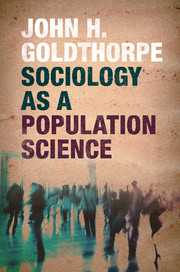Book contents
- Frontmatter
- Dedication
- Contents
- Acknowledgements
- Introduction
- 1 Sociology as a population science: the central idea
- 2 Individual variability in human social life
- 3 The individualistic paradigm
- 4 Population regularities as basic explananda
- 5 Statistics, concepts and the objects of sociological study
- 6 Statistics and methods of data collection
- 7 Statistics and methods of data analysis
- 8 The limits of statistics: causal explanation
- 9 Causal explanation through social mechanisms
- Conclusion
- References
- Index
1 - Sociology as a population science: the central idea
Published online by Cambridge University Press: 05 December 2015
- Frontmatter
- Dedication
- Contents
- Acknowledgements
- Introduction
- 1 Sociology as a population science: the central idea
- 2 Individual variability in human social life
- 3 The individualistic paradigm
- 4 Population regularities as basic explananda
- 5 Statistics, concepts and the objects of sociological study
- 6 Statistics and methods of data collection
- 7 Statistics and methods of data analysis
- 8 The limits of statistics: causal explanation
- 9 Causal explanation through social mechanisms
- Conclusion
- References
- Index
Summary
Sociology should be understood as a population science in the sense of Neyman (1975).
On the occasion of the 500th anniversary of the birth of Nicholas Copernicus (1473–1543), the US National Academy of Sciences sponsored a collection of essays on ‘quasi-Copernican’ scientific revolutions. The volume was edited by the Polish-born statistician Jerzy Neyman, who supplied brief introductions to its several sections. In one such introduction, to a series of essays on ‘The Study of Chance Mechanisms – A Quasi-Copernican Revolution in Science and Mathematics’, Neyman (1975: 417) made the following observation:
Beginning with the nineteenth century, and increasing in the twentieth, science brought about ‘pluralistic’ subjects of study, categories of entities satisfying certain definitions but varying in their individual properties. Technically, such categories are called ‘populations’.
Neyman emphasised that populations in this technical sense could, substantively, be of quite different kinds. They could be human or other animal populations, but also populations of, say, molecules or galaxies. The common feature of such populations was that, while their individual elements were subject to considerable variability and might appear, at least in some respects, indeterminate in their states and behaviour, they could nonetheless exhibit aggregate-level regularities of a probabilistic kind.
The aims of a science dealing with such pluralistic subjects of study – or, that is, of what could be called a ‘population science’ – were then twofold. The initial aim was to investigate, and to establish, the probabilistic regularities that characterise a particular population, or its appropriately defined subpopulations. In this regard, Neyman saw the use of statistical methods of both data collection and analysis as being essential. And indeed, fifty years previously, R. A. Fisher (1925: 2) had already defined statistics as ‘the study of populations, or aggregates of individuals’, and had represented statistics as foundational for all sciences that were primarily concerned with the properties of aggregates rather than of their individual members. It may moreover be noted, in view of what is to follow, that Fisher then added the remark that ‘Statistical methods are essential to social studies, and it is principally by the aid of such methods that these studies may be raised to the rank of science.’
- Type
- Chapter
- Information
- Sociology as a Population Science , pp. 7 - 16Publisher: Cambridge University PressPrint publication year: 2015



